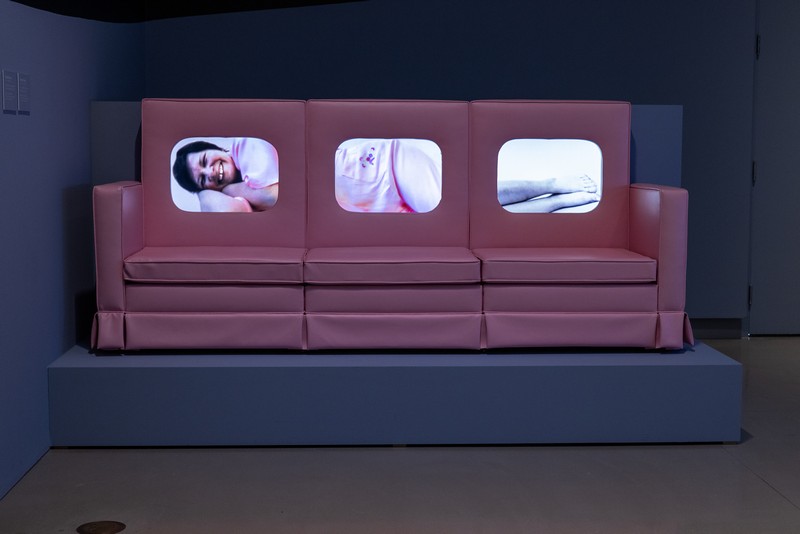“Sheltered in Place,” new exhibition at the Ottawa Art Gallery
Maureen Korp
In these fraught times, what reminds you of another, of someone not beside you now? Is it an old photograph? A song? Something on the news today? A voice message you can never, ever erase?
The Ottawa Art Gallery has a new exhibition of portraiture, portraiture seen as the bric-a-brac of memory, personal history, storyline. Entitled “Sheltered in Place: Portraits of Self, Family, and Community,” the subtitle indicates its wide reach. The exhibition is curated by Catherine Sinclair, Rebecca Basciano, and Michelle Gewurtz. All of the work is by Ottawa artists.
“Ba-Bye Mammy, Ba-Bye,” 2008, a six-minute film by Patrice James, is a montage of familiar banal imagery: the family Christmas tree, outings to Upper Canada Village, a child in her First Communion dress, etc. The film’s narration is constructed from voice messages—everyday reminders from Mammy to her children, and they to her: “take care of the garden,” “keep the doctor’s appointment,” “stay in touch.” James made the film as a poignant memorial to her mother, Margaret Ramirez, 1946-2007.
When someone has died, how often is it we wish there were something more we could say? “Coming Home,” 2002, a drawing by Annie Pootoogook, is a scene of joy and surprise. Through an open door, a man has just walked in. The woman at the kitchen counter stands amazed, reaching forth her hands. He is here—in front of her. He is not dead. Wait. Are those angel wings? Or just two coats on the wall behind him? Is he here to stay?
Annie Pootoogook, 1969-2016, born in Nunavut, died in the Rideau River.
“Portrait of the Viewer as Artist,” 2012, by Max Dean takes us all into the picture. Three sets of glass shelving and two large tables display a variety of objects against a long wall. There are toys, clocks, photo albums, several hearts of rock, and more. Where does your eye take you? Look. You are here, too. The wall is also a mirror. Memories are chosen. You are the memory keeper.
A good song, a good beat, can make everything better, as we see in “The Outsiders,” 2009, by Ron Noganosh. In this sculpture, a toe-tapping band of four critters of the forest has been constructed of detritus. They play drums, piano, guitar. The sassy heads of the two guitarists are made of bicycle seats. Under the strings of their guitars are CDs, should you wish to buy. The drummer is well rooted. Noganosh, 1949-2017, born on the Magnetawan First Nation, knew old stories stay alive when they are walked, talked, told to others. The artist lived many years in Ottawa.
Jessie Oonark gives us another example of story in her stonecut print entitled “Little Woman,” 1983. The girl wears the traditional dress and tattoos of the Inuit, but holds aloft in her hands two stick figures. Will they fly? Where to? Oonark, 1906-1985, born in Nunavut, died in Manitoba.
Martha Kyak’s “Sakiaguti,” 2021 is a gloriously festooned tunic of sealskin and velvet flowers. Born in Nunavut, Kyak is the creator of InukChic, a fashion line made here in Ottawa.
Living, breathing people keep traditions alive; historians do not. The historian’s point-of-view is one necessarily dated to times past, not present. This paradox animates the work of both Christopher Lea Dunning and Kosisochukwu Nnebe.
From Christopher Lea Dunning’s point of view, 47 Ottawa artists were somehow omitted from an authoritative history of French art. Dunning corrected the problem in his bookwork entitled Beneath the Image, 2016-17. In a multimedia presentation we see the original along with Dunning’s additions.
Kosisochukwu Nnebe looks for multiple points of view in her work too. “Untitled I, 2017” for example, is a wall sculpture of angles, left and right, showing, sometimes, a woman looking at herself in a hand mirror. Other times, however, the viewer sees only herself. The sculpture is one of a series entitled “Black Woman/ Hyper/ in/ visibility,” 2017.
Do not wait for others to keep memory alive. Speak it, breathe it. Faisa Omer photographed the boys hanging around the neighbourhood. The eight photographs of “Ritchie Street,” 2020, are of Black youth, each with a story to tell
The stories must be told—good, bad, ridiculous. What brought laughter then is likely a rib-tickler today as we see in “The Sunlight Zone, Au-delà du réel (The Twilight Zone),” 2001, by Chantal Dahan. A pink leather sofa is home to a three-screen view of a woman stretched out on her side. She is laughing and laughing, oh how her feet are twiddling merrily. Wasn’t that a great time we all had?

Photo: Chris Snow/OAG
The gallery’s labels for work displayed provide biographical data for the artists in multiple languages, including: Anishinaabemowin (Ojibwe), English, French, Igbo, Inuktitut, and Somali—all languages spoken today in Ottawa by a good number of people, some of whom are artists.
Current exhibitions at the gallery
“Sheltered in Place: Portraits of Self, Family, and Community,” until August 15, 2021
“Filtered,” until December 19, 2021
“(Re) Collecting the Group of Seven,” until November 7, 2021
50 Mackenzie King Bridge / 5 Daly Ave.
Free admission. Accessible. Open Wednesday-Sunday, 10 a.m.- 6 p.m. Visits must be booked in advance: oaggao.ca/oag-reopening
Please note that Maureen Korp visited the OAG prior to the latest round of COVID-19 restrictions. The OAG is currently closed in accordance with Public Health guidelines. Visit: oaggao.ca/plan-your-visit for the latest updates.
